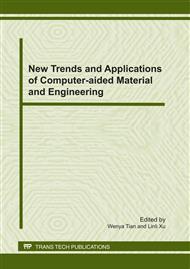p.332
p.337
p.342
p.348
p.353
p.358
p.363
p.368
p.373
Simulation Research on Cutting Process of Single Abrasive Grain Based on FEM and SPH Method
Abstract:
Cutting process of single abrasive grain was simulated by Smoothed Particle Hydrodynamics and Finite Element Method. Chip mechanism of single abrasive grain was analyzed according to the stress variation of grain and workpiece material, and motion situation of smoothed particles in cutting layer. Effects of abrasive grain rake angle and cutting depth on cutting deformation of workpiece material were also analyzed. It is concluded that workpiece material occurs to plastic deformation, flows to the side and front owing to the extrusion of abrasive grain, and finally forms chip in front of abrasive grain; cutting capability increases with the increase of abrasive grain rake angle, it results in the increase of material protrusion in front of abrasive rain and relatively decrease of material protrusion beside abrasive grain; workpiece material deformation and cutting force increase with the increase of cutting depth. Scratching experiment of abrasive grains was carried out by using vitrified bonded CBN block. It is found that deformation laws of workpiece material in the simulation and experiment are consistent. It is proved that the simulation results are correct, and the simulation method is feasible
Info:
Periodical:
Pages:
353-357
Citation:
Online since:
January 2011
Authors:
Price:
Сopyright:
© 2011 Trans Tech Publications Ltd. All Rights Reserved
Share:
Citation:


